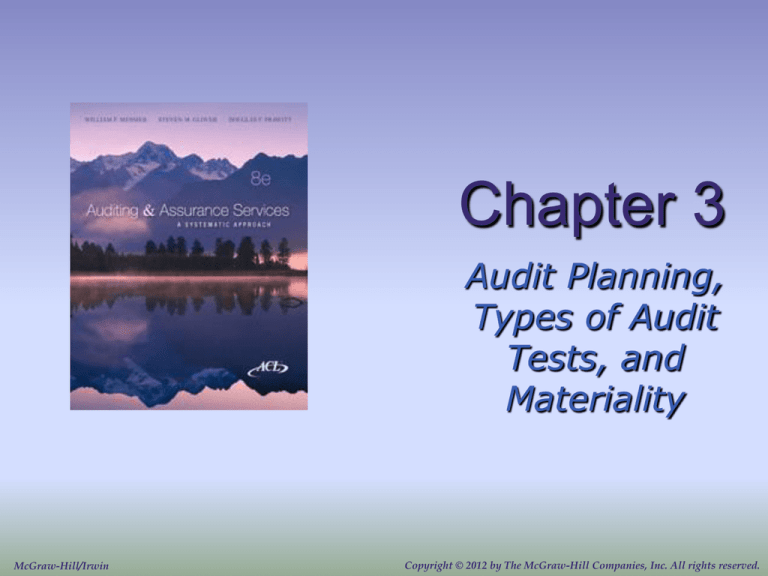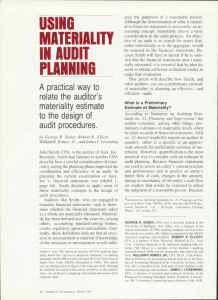
Chapter 3
Audit Planning,
Types of Audit
Tests, and
Materiality
McGraw-Hill/Irwin
Copyright © 2012 by The McGraw-Hill Companies, Inc. All rights reserved.
The Phases of an Audit That Relate to
Audit Planning
LO# 1
3-2
LO# 2
Preliminary Engagement Activities
Determine the Audit
Engagement Team
Requirements
Assess Compliance with
Ethical Requirements,
Including Independence
3-3
Establish Terms of the
Engagement
LO# 3
In establishing the terms of the engagement,
three topics must be discussed:
1.The engagement letter;
2.Using the work of the internal auditors; and
3.The role of the audit committee.
The terms of the engagement, which are documented in
the engagement letter, should include the objectives of
the engagement, management’s responsibilities, the
auditor’s responsibilities, and the limitations of the
engagement.
Who signs the engagement letter?
3-4
LO# 4
The Engagement Letter
The engagement letter formalizes the arrangement reached
between the auditor and the client.
In addition to the items mentioned in the
sample engagement letter in Exhibit 3-1 in
the textbook, the engagement letter may
include:
• Arrangements for use of specialists or
internal auditors.
• Any limitations of liability of the auditor
or client.
• Additional services to be provided.
•Arrangements regarding other services.
3-5
LO# 5
Internal Auditors
3-6
LO# 6
The Audit Committee
Subcommittee
of the board of
directors
Section 301 of Sarbanes-Oxley Act requires the
following for audit committee members of
publicly held companies:
•Member of board of directors and independent.
•Directly responsible for overseeing work of any
No specific
requirements
for privately
held companies
registered public accounting firm employed by the
company.
•Must preapprove all audit and nonaudit services
provided by its auditors.
•Must establish procedures to follow for complaints.
•Must have authority to engage independent counsel.
3-7
LO# 7
Planning the Audit
When preparing the audit plan, the auditor should be guided
by the results of the client acceptance/continuance process,
procedures performed to gain an understanding of the entity,
and preliminary engagement activities.
Additional steps:
•Assess business risks.
•Establish materiality.
•Consider multilocations.
•Assess the need for specialists.
•Assess the possibility of illegal acts.
•Identify related parties.
•Consider additional value-added services.
Let’s look at
each
of these steps.
3-8
LO# 7
Document Audit Strategy
3-9
LO# 9
Types of Audit Tests
Risk Assessment
Procedures
Used to obtain an understanding of
the entity and its environment,
including its internal control.
Tests of Controls
Directed toward the evaluation of the
effectiveness of the design and
operation of internal controls.
Substantive
Procedures
Detect material misstatements in a
transaction class, account balance,
and disclosure component of the
financial statements.
3-10
LO# 10
Materiality
The magnitude of an omission or misstatement of
accounting information that makes it probable that
the judgment of a reasonable person relying on
the information would be changed or influenced
by the omission or misstatement.
Materiality is not an absolute and
it is not a black or white issue!
The determination of materiality
requires professional judgment.
3-11
Steps in Applying Materiality
on an Audit
LO# 11
Step 1:
Determine a materiality level for the overall financial statements
(planning materiality)
Step 2:
Determine tolerable misstatement
(allocation of materiality at individual account/class of transactions level)
Step 3:
Evaluate auditing findings
(near the end of the audit)
3-12
End of Chapter 3
3-13









